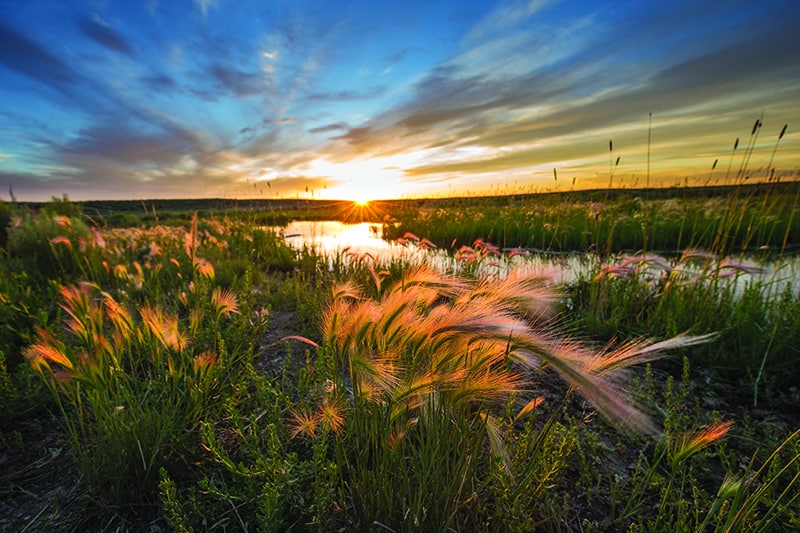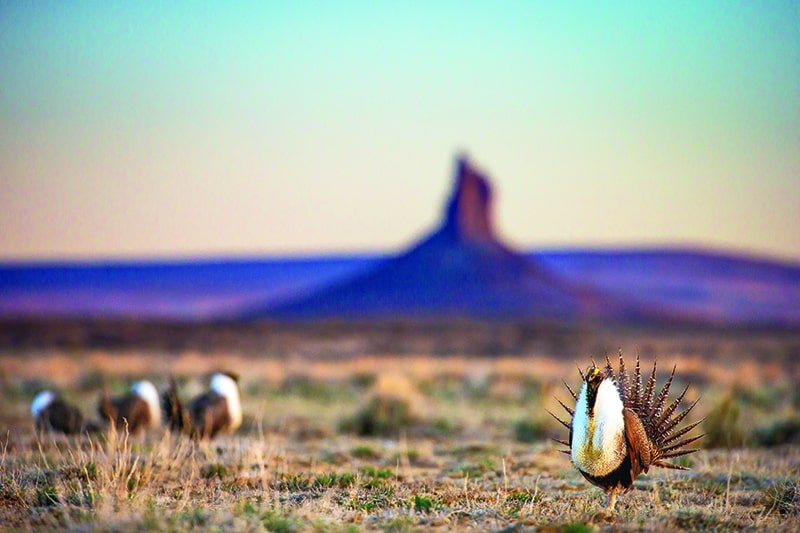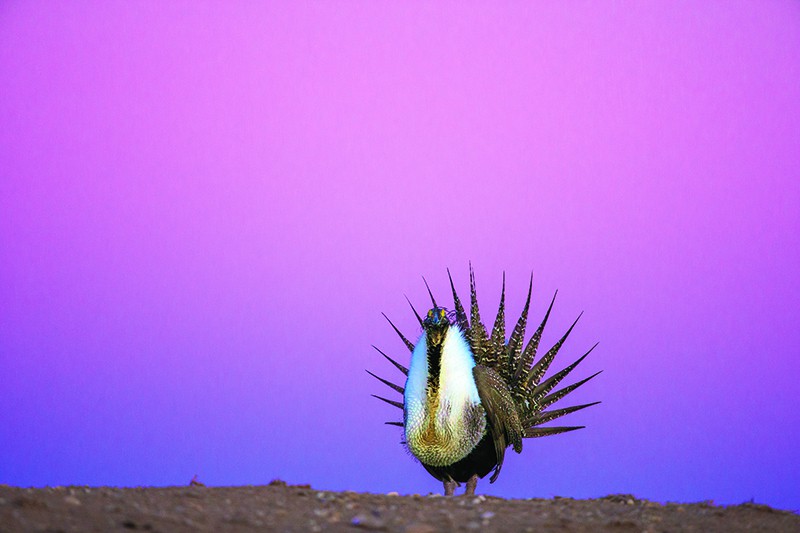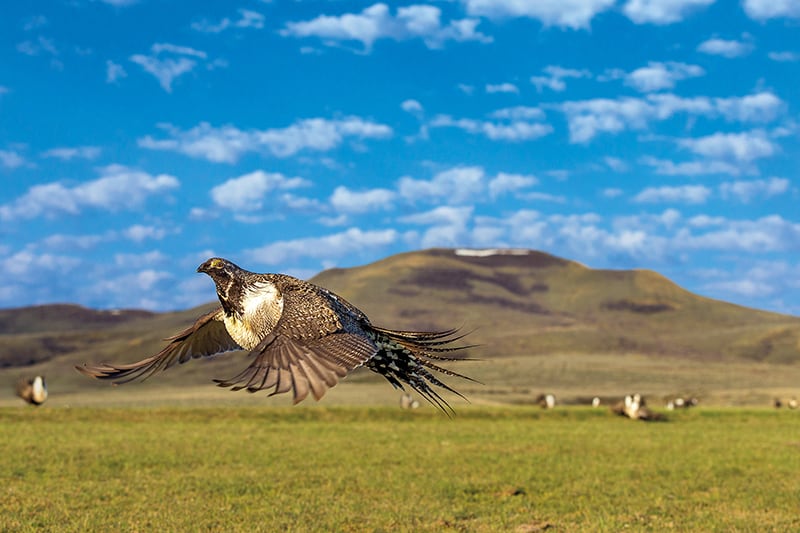Read The
Current Issue
Noppadol Paothong’s photography exhibit at the National Museum of Wildlife Art highlights the importance of greater sage-grouse to Western culture and conservation.
By maggie theodora // Photography by Noppadol Paothong
WILDLIFE PHOTOGRAPHER NOPPADOL Paothong spent eleven years working on his first book, Save the Last Dance. It features images of seven species of North American grassland grouse. His second book, Sage Grouse: Icon of the West—which focuses on a single species of grouse, the greater sage-grouse—took five years and is the backbone of an exhibit of the same name hanging at the National Museum of Wildlife Art through May 3. “You’d think with only one species, it would have gone much faster, but I wanted the book to be bigger than the species,” says Paothong, an associate fellow with the International League of Conservation Photographers. “These aren’t just a bird, but part of the Western landscape and of Native American dances and traditions. Early pioneers hunted and ate them. They are an indicator species; the health of their population offers insight into what might be happening with the 350-some other species that share the same terrain. They’re iconic.” More of these iconic birds live in Wyoming than anywhere else in the world, and many of Paothong’s images in Sage Grouse (the exhibit and the book) were taken in the state.
“As a wildlife art museum, it’s one of our goals to educate visitors about topics that affect wildlife and our natural world,” says Tammi Hanawalt, Ph.D, curator of art at the National Museum of Wildlife Art (NMWA). “With Sage Grouse: Icon of the West, we have an exhibit about a species that, if their habitat is destroyed, it affects the whole ecosystem of the surrounding area, which our museum is right in the middle of. [The NMWA] seemed like the perfect place for this exhibit.”
“We have an exhibit about a species that, if their habitat is destroyed, it affects the whole ecosystem of the surrounding area, which our museum is right in the middle of. The [NMWA] seemed like the perfect place for this exhibit.”
—Dr. Tammi Hanawalt, Curator of Art at NMWA
The Sage Grouse exhibit features about sixty of Paothong’s photographs. “I selected images with the goal of telling a story,” he says. “Each image leads to the next one. There are shots of males at leks [mating areas], and these are followed by images that show the species’ nesting season, life cycle, the winter, the ecosystem, and what’s happening to their environment.” Hanawalt says, “It is an emotional exhibit. He takes you through the life cycle of the grouse, and you see grouse that have died because of human advancement into their environment.”
The exhibit also includes images that show the species’ importance to Native Americans, who hunted the birds and also mimicked their mating displays during ceremonial dances. “These birds have a cultural importance as well as [significance] to conservation—that’s a big part of their story and what makes them important,” Paothong says. “I can’t think of a better place than Jackson Hole to share their story.” Wildlifeart.org JH

Greater Sage-Grouse in Wyoming
The greater sage-grouse is the largest grouse in North America and lives in eleven Western states and two Canadian provinces. There were once about sixteen million of the birds in North America, but today less than 300,000 remain. About 37 percent of these live in Wyoming. “Wyoming has the world’s largest population of greater sage-grouse,” Noppadol Paothong says. This is because of the species’ habitat. They live in the sagebrush steppe, also known as the “sagebrush sea,” that blankets the plateaus and basins of the Intermountain West. “Across the continent, we’ve lost about half of what used to be sage-grouse habitat,” says Tom Christensen, a wildlife biologist and coordinator of the sage-grouse program at the Wyoming Game and Fish Department who retired in 2018. “Wyoming still has about 90 percent of its sagebrush landscape, though.”
In other areas of the country, sagebrush habitat has been lost to agriculture and development. However, in Wyoming, forty-three million acres—an area about equal in size to the state of Florida—remains sagebrush. “In neighboring Idaho, a lot of what was sage-grouse habitat is now potato fields,” Christiansen says. “In Wyoming, we don’t have the climate and soils to make agriculture pay. Saving sage-grouse habitat wasn’t anything altruistic on our part.” While Wyoming doesn’t need to worry about agricultural development, energy development, including oil and gas drilling and wind turbines, does adversely affect sage-grouse habitat. Since 2008, to prevent the species being listed on the federal Endangered Species Act, Wyoming has had gubernatorial executive orders in place that attempt to balance the protection of sage-grouse habitat with energy development.
What the heck is a lek?
The areas where sage-grouse mate in the spring are called leks. These areas are usually flat and open, so female grouse can see the males’ elaborate mating rituals. Populations usually return to the same leks year after year. While sage-grouse as a species are particularly sensitive to human disturbance, it’s possible to settle yourself a safe distance from a known lek and watch their mating antics via binoculars. “It’s an amazing sight,” says wildlife biologist Tom Christiansen. “I’m always surprised by the number of local folks who have never seen a sage-grouse strut on a lek.”

Meet Noppadol Paothong
“I’ve been watching Noppadol’s rise for a long time,” Jackson Hole–based wildlife photographer Tom Mangelsen told the NMWA’s annual magazine Call of the Wild. “Sure I admire his skill with a camera and the compositional design of his images, but most of all I respect the feel and knowledge he has for the animals he portrays. Great photos either have heart or they don’t.”
Growing up in Thailand, Paothong did not think about wildlife photography as a career. “My mom always knew I would be something different. I wasn’t that typical kid in the classroom; I wanted to go outside and fish or look at insects,” he says. Wildlife photography wasn’t on his radar even after he came to the U.S. as a foreign exchange student in 1993. “I did not plan on living here. My mom wanted me to get educated and learn English and then go back home and help,” he says. After studying for a couple of years in northern Idaho, Paothong moved to Missouri and, he says, “I just fell in love with the landscape there.” He graduated from Missouri Southern State University with a degree in communications in 2001. Before he had even graduated, he was working as a photojournalist at the Joplin Globe and doing wildlife photography in his spare time. It was while at the Globe that his editor sent him on an assignment to a small town in southwest Missouri to photograph greater prairie chickens. “I immediately felt in love with these birds, and it was the beginning of my obsession to photograph all prairie grouse species across the U.S., from the West (sage-grouse and sharp-tailed grouse) to southern Texas (endangered Attwater’s prairie chicken) to Martha’s Vineyard (extinct heath hen).” That year, Paothong started work on his first book, Save the Last Dance. He thinks it was because of his commitment to this book—this is the one he worked on for eleven years—that the Missouri Department of Conservation hired him as a staff photographer in 2006. “It showed the depth and level of my commitment for a long-term project,” he says.
Paothong has been with the department ever since, shooting more than 160 covers for its monthly magazine, Missouri Conservationist, which publishes about 500,000 copies of every issue. “It isn’t just a dream job, but it is the best for me as it allows me to explore every corner of Missouri and learn to appreciate the state,” he says. “Even Audubon doesn’t have staff photographers.”
With Icon of the West published and the exhibit based on it traveling to museums around the West, Paothong is looking for his next big project. “I’m actually more of an insect person [than birds] and have been working with a lot of pollinator species. It’s a different direction, and it doesn’t mean I feel like I’ve finished with sage-grouse. I am still photographing them, too. I think that, with all of the years I’ve photographed them, I’ve only scratched the surface.” npnaturephotography.com







